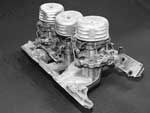
Jim Taylor, HPP contributor and the proprietor of Phillipsburg, New Jersey-based Jim Taylor's Engine Service, remembers the days when Pontiac's Tri-Power setups were plentiful. It wasn't uncommon for him to get a unit in for repair that needed only a rebuild, which was completed with little labor and few problems.
Unfortunately, those days are over. With Tri-Powers becoming more and more scarce, those correct assemblies that needed only a freshening have been replaced with beaten-up, cobbled together collections of parts that would make the most well-tuned Pontiac stumble. Carbs that have been swapped from the center spot to an end; incorrectly applied gaskets that create major vacuum leaks from improper sealing; linkages that are homemade or from other vehicle;. and botched repairs to the carb body, throttle shaft, and throttle plates that threaten to leave these highly sought-after symbols of Pontiac's heritage in the junkyard for good. It's not a good situation.
But there are solutions to these difficult problems. Taylor is still fighting the good fight and restoring Trips to their former glory, so we traveled to Phillipsburg to observe how he does it. As we walked into the shop, we found a dirt- and grime-covered 1962 manifold with three deuces sitting on a table. Jim needed a core to build a 1965 spec. Tri-Power (he already had the intake manifold) for a customer so he found this assembly at a swap meet, and he knew that it would be a doozy to work with.
But it was only after he tore it down that we saw just how bad it was. Follow along as we tackle the first part of a multi-part series on how to correctly restore a Pontiac Tri-Power.